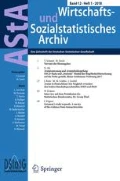Zusammenfassung
In dem vorliegenden Beitrag steht die sequentielle Analyse von Finanzzeitreihen im Vordergrund. Der Erwartungswert und die Varianz von Zeitreihen sollen simultan überwacht werden. Zunächst werden konventionelle Kontrollkarten als wesentliches Werkzeug der statistischen Prozesskontrolle mit einer zuvor eingeführten charakteristischen Größ e kombiniert. Diese charakteristische Größ e ist ein Vektor, der die Residuen eines angepassten Modells und deren Quadrate beinhaltet. Des Weiteren müssen die entsprechenden Prozeduren anhand einer Simulationsstudie kalibriert werden. Auß erdem wird die Anwendung dieser Prozeduren mittels eines empirischen Beispiels verdeutlicht. Im Rahmen der empirischen Analyse wird der Deutsche Aktienindex in den Jahren 2006 bis 2008 während der Finanzkrise untersucht. Das wesentliche Ziel ist hierbei die Identifikation von strukturellen Veränderungen im Erwartungswert bzw. in der Varianz des Aktienindex anhand von Prognosen aus dem jeweils angepassten Modell. Dabei werden die lineare Regression mit Zeitreihenfehlern angewendet auf den betrachteten Aktienindex sowie das autoregressive Modell bedingter Heteroskedastizität angewendet auf logarithmierte Renditen in Betracht gezogen. Diese Strukturbrüche werden in Form von Signalen der betrachteten Residuenkarten ersichtlich. Auf diese Weise lassen sich strukturelle Schwankungen auf dem Kapitalmarkt während wirtschaftlicher Krisen visualisieren.
Abstract
In this paper, the focus is on sequential analysis of financial time series. Mean and variance of time series are simultaneously monitored. Initially, conventional control charts, well-known tools of statistical process control, are combined with the previously introduced characteristic quantity. The considered characteristic quantity is a vector including the residuals of the fitted model and their squares. Further, the respective control procedures are calibrated via simulation. The effectiveness of control schemes is demonstrated in the empirical example, where the main German share price index is studied during the financial crisis from 2006 until 2008. The main purpose is the identification of structural changes in mean or variance using predictions based on linear regression with time series errors applied to the considered price index and the GARCH model applied to logarithmic returns. Structural breaks are visualized by signals of the considered residual charts. Therefore, fluctuations on the capital market during financial crises are illustrated.






References
Bodnar O, Schmid W (2007) Surveillance of the mean behavior of multivariate time series. Statistica Neerlandica 61:1–24
Bollerslev T (1986) Generalized autoregressive conditional heteroscedasticity. J Econ 31(3):307–327
Chu CSJ, Stinchcombe M, White H (1996)FA2 Monitoring structural change. Econometrica 64(5):1045–1065
Durbin J, Watson GS (1950) Testing for serial correlation in least squares regression, I. Biometrika 37(3–4):409–428
Durbin J, Watson GS (1951) Testing for serial correlation in least squares regression, II. Biometrika 38(1–2):159–179
Durbin J, Watson GS (1971) Testing for serial correlation in least squares regression, III. Biometrika 58(1):1–19
Engle RF (1982) Autoregressive conditional heteroscedasticity with estimates of the variance of United Kingdom inflation. Econometrica 50(4):986–1007
Garthoff R (2014) Sequential analysis of the mean vector of conditional correlation models. European University Viadrina, Frankfurt (Oder), Working Paper
Garthoff R, Okhrin I, Schmid W (2014) Statistical surveillance of the mean vector and the covariance matrix of nonlinear time series. AStA Adv Stat Anal 98(3):225–255
Garthoff R, Okhrin I, Schmid W (2013) Control charts for multivariate nonlinear time series. REVSTAT – Stat J. accepted for publication
Garthoff R, Schmid W (2014) Statistical process control of DCC models. European University Viadrina, Frankfurt (Oder), Working Paper
Greene WH (2008) Econometric analysis. Pearson, Boston
Hotelling H (1947) Multivariate quality control, In: Eisenhart C, Hastay MW, Wallis MA (eds) Techniques of Statistical Analysis. McGraw-Hill, New York, S. 339–350
Kramer H, Schmid W (1997) EWMA charts for multivariate time series. Seq Anal 16:131–154
Lowry CA, Woodall WH, Champ CW, Rigdon SE (1992) A multivariate exponentially weighted moving average control chart. Technometrics 34:46–53
Page ES (1954) Continious inspection schemes. Biometrika 41:100–114
Pignatiello JJ, Runger GC (1990) Comparison of multivariate CUSUM charts. J Qual Technol 22:173–186
Roberts SW (1959) Control charts based on geometric moving averages. Technometrics 1:239–250
Śliwa P, Schmid W (2005a) Monitoring the cross-covariances of a multivariate time series. Metrika 61:89–115
Śliwa P, Schmid W (2005b) Surveillance of the covariance matrix of multivariate nonlinear time series. Statistics 39:221–246
Shapiro SS, Wilk MB (1965) An analysis of variance test for normality (for complete samples). Biometrika 52:591–611
Spiwoks M, Hein O (2007) Die Währungs-, Anleihen- und Aktienmarktprognosen des Zentrums für Europäische Wirtschaftsforschung. AStA Wirtsch Sozialstat Arch 1(1):43–52
Theodossiou PT (1993) Predicting shifts in the mean of a multivariate time series process: an application in predicting business failures. J Am Stat Assoc 88:441–449
White H (1980) A heteroskedasticity-consistent covariance matrix estimator and a direct test for heteroskedasticity. Econometrica 48(4):817–838
Whittle P (1951) Hypothesis testing in time series analysis. Almquist and Wicksell
Wied D, Arnold M, Bissantz N, Ziggel D (2013) Über die Anwendbarkeit eines neuen Fluktuationstests für Korrelationen auf Finanzzeitreihen. AStA Wirtsch Sozialstat Arch 6(3–4):87–103
Wied D, Galeano P (2013) Monitoring correlation changes in a sequence of random variables. J Stat Plan Inference 143(1):186–196
Author information
Authors and Affiliations
Corresponding author
Rights and permissions
About this article
Cite this article
Garthoff, R. Sequentielle Überwachung von Finanzzeitreihen anhand von Residuenkarten. AStA Wirtsch Sozialstat Arch 8, 91–113 (2014). https://doi.org/10.1007/s11943-014-0145-6
Received:
Accepted:
Published:
Issue Date:
DOI: https://doi.org/10.1007/s11943-014-0145-6
Schlüsselwörter
- Statistische Prozesskontrolle
- CUSUM-Karten
- EWMA-Karten
- Lineare Regression mit Zeitreihenfehlern
- GARCH-Prozesse
- Prognosen

